Strategic Management for Procter & Gamble: SWOT and PESTLE Analysis
21 Pages5987 Words326 Views
Added on 2023-06-08
About This Document
This report presents a strategic management analysis of Procter & Gamble, including its history, mission, and vision. It also includes a SWOT analysis of the company's internal environment and a PESTLE analysis of its external environment. The report highlights the company's strengths, weaknesses, opportunities, and threats, and how political, economic, social, technological, legal, and environmental factors affect its operations. The report concludes with recommendations for further improvement.
Strategic Management for Procter & Gamble: SWOT and PESTLE Analysis
Added on 2023-06-08
ShareRelated Documents
STRATEGIC MANAGEMENT
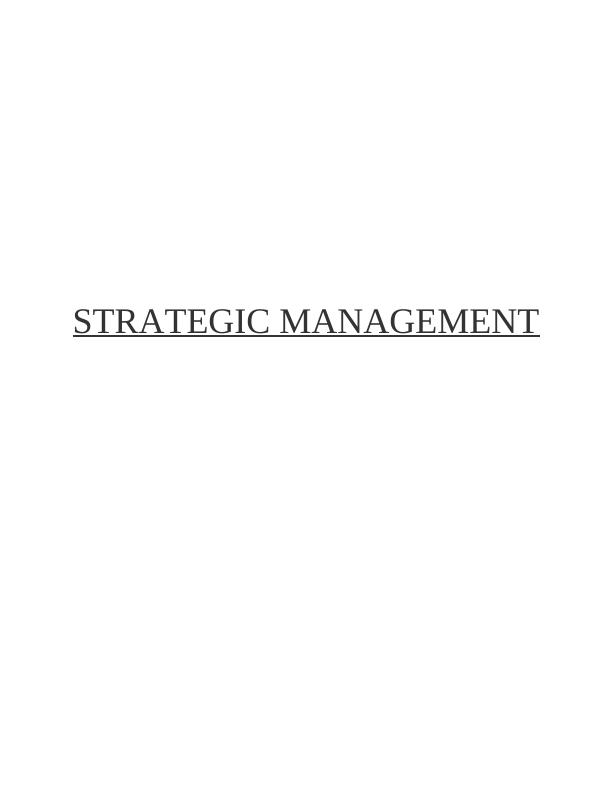
EXECUTIVE SUMMARY
The report is intended to present an intensive organizational strategy in order to be
competitive and lucrative in prevailing market circumstances. With this regard Procter & gamble
company has been taken. The report has depicted background information of this organization
such as its foundation, ownership and course of actions. To perceive the organizational strategy
deeply, its mission, vision was also scrutinized.
For analysing both internal and external environment where business is getting operated,
a range of models were used. To analyse internal business environment SWOT analysis was
carried out, and for external business environment PESTLE analysis has been taken into
consideration. From this report it can be deciphered that despite having severe competition in the
market the organization is notching up sort of favourable notions. Here, its strategic factors were
critically analysed in attempt to extend some recommendations for further betterment and
eradication of prevailing bottlenecks, which are having potential to bring catastrophe to Procter
& Gamble.
The report is intended to present an intensive organizational strategy in order to be
competitive and lucrative in prevailing market circumstances. With this regard Procter & gamble
company has been taken. The report has depicted background information of this organization
such as its foundation, ownership and course of actions. To perceive the organizational strategy
deeply, its mission, vision was also scrutinized.
For analysing both internal and external environment where business is getting operated,
a range of models were used. To analyse internal business environment SWOT analysis was
carried out, and for external business environment PESTLE analysis has been taken into
consideration. From this report it can be deciphered that despite having severe competition in the
market the organization is notching up sort of favourable notions. Here, its strategic factors were
critically analysed in attempt to extend some recommendations for further betterment and
eradication of prevailing bottlenecks, which are having potential to bring catastrophe to Procter
& Gamble.
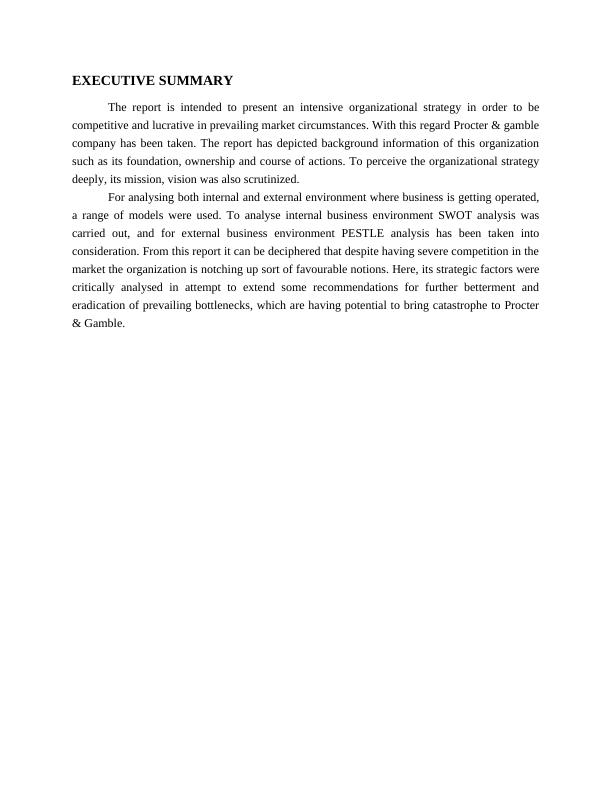
Table of Contents
EXECUTIVE SUMMARY.............................................................................................................2
INTRODUCTION...........................................................................................................................4
MAIN BODY...................................................................................................................................4
Task-1..............................................................................................................................................4
Procter & Gamble (P&G)............................................................................................................4
Vission of P&G............................................................................................................................6
Stakeholders of P&G...................................................................................................................6
Task-2..............................................................................................................................................7
S.W.O.T. Analysis ......................................................................................................................7
PESTLE Analysis........................................................................................................................9
TASK 3..........................................................................................................................................10
Critical analysis of Procter and Gamble business strategies......................................................10
TASK 4..........................................................................................................................................12
Conclusion and outlining the areas of P&G business strategy and recommendations for further
improvement..............................................................................................................................12
CONCLUSION..............................................................................................................................15
REFERENCES................................................................................................................................1
EXECUTIVE SUMMARY.............................................................................................................2
INTRODUCTION...........................................................................................................................4
MAIN BODY...................................................................................................................................4
Task-1..............................................................................................................................................4
Procter & Gamble (P&G)............................................................................................................4
Vission of P&G............................................................................................................................6
Stakeholders of P&G...................................................................................................................6
Task-2..............................................................................................................................................7
S.W.O.T. Analysis ......................................................................................................................7
PESTLE Analysis........................................................................................................................9
TASK 3..........................................................................................................................................10
Critical analysis of Procter and Gamble business strategies......................................................10
TASK 4..........................................................................................................................................12
Conclusion and outlining the areas of P&G business strategy and recommendations for further
improvement..............................................................................................................................12
CONCLUSION..............................................................................................................................15
REFERENCES................................................................................................................................1
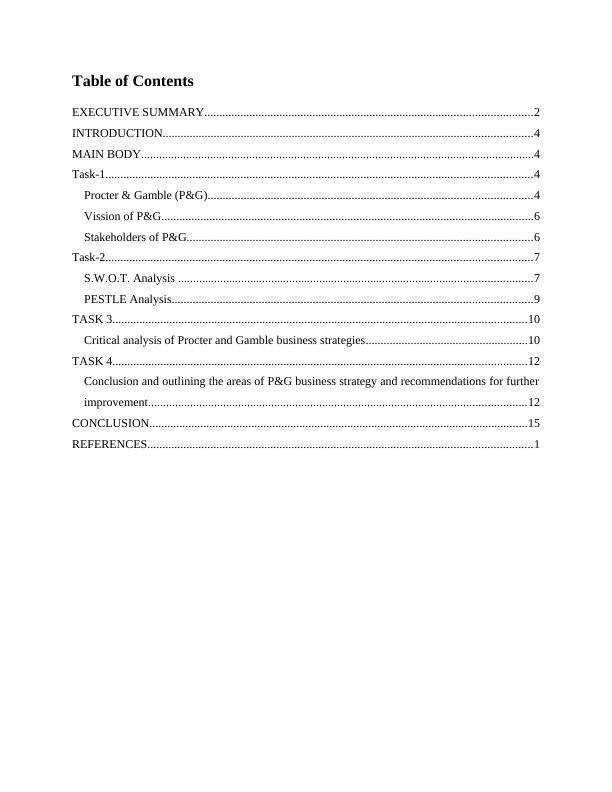
INTRODUCTION
The process of planning, organizing, implementing and assessing a strategy is called
strategic management. Changes in the internal and external environment of the organization
forces the management for planning and evaluating different strategies to be pursued for profit
maximization and smooth running of the firm. This process of strategic management enables the
organization's long term sustainability and helps to determine a direction in which the firm has to
operate. These plans enable the organization to develop a competitive edge over its competitors.
Maintaining the existing customer base and targeting the new ones with different tactics is the
main focus of strategic management.
Procter and Gamble is an American multinational firm founded in 1837 by William
Procter and James Gamble (Muhamad, 2021). Company deals in personal care products such as
beauty products, hair care products, baby and feminine hygiene products etc. establishment of
P&G has been flourished in the different parts of the world offering their customers with a wide
range of product and services.
The following report will be highlighting the past and present scenario and the futuristic
strategies of the organization. Successful strategies that would be followed by the organization to
attain profit in past few years will be discussed.
MAIN BODY
Task-1
Procter & Gamble (P&G)
Procter and gamble is a U.S. based organization and its headquarter is located in
Cincinnati, Ohio. The organization currently operates in many countries globally. The brand has
evolved with the time in various market segments with different product and services. In the past
times the brand dealt in food industry with Pringles (Leiblein and Reuer, 2020). In the initial
period the company made little profits but during the American civil war the brand took up road
towards success by winning the contract for supplying of soaps and candles to the union army.
The company was recognized in the market when they launched an inexpensive soap called
Ivory with “floating soap” USP. Diversification in the ranges of products was obtained in early
19's by producing vegetable oils. In mid 19's the company started establishing their factories and
outlets in different countries. With the acquaintance of Thomas Hedley Co. the company entered
the markets of UK. Over the period of time the company grown into many different branches by
The process of planning, organizing, implementing and assessing a strategy is called
strategic management. Changes in the internal and external environment of the organization
forces the management for planning and evaluating different strategies to be pursued for profit
maximization and smooth running of the firm. This process of strategic management enables the
organization's long term sustainability and helps to determine a direction in which the firm has to
operate. These plans enable the organization to develop a competitive edge over its competitors.
Maintaining the existing customer base and targeting the new ones with different tactics is the
main focus of strategic management.
Procter and Gamble is an American multinational firm founded in 1837 by William
Procter and James Gamble (Muhamad, 2021). Company deals in personal care products such as
beauty products, hair care products, baby and feminine hygiene products etc. establishment of
P&G has been flourished in the different parts of the world offering their customers with a wide
range of product and services.
The following report will be highlighting the past and present scenario and the futuristic
strategies of the organization. Successful strategies that would be followed by the organization to
attain profit in past few years will be discussed.
MAIN BODY
Task-1
Procter & Gamble (P&G)
Procter and gamble is a U.S. based organization and its headquarter is located in
Cincinnati, Ohio. The organization currently operates in many countries globally. The brand has
evolved with the time in various market segments with different product and services. In the past
times the brand dealt in food industry with Pringles (Leiblein and Reuer, 2020). In the initial
period the company made little profits but during the American civil war the brand took up road
towards success by winning the contract for supplying of soaps and candles to the union army.
The company was recognized in the market when they launched an inexpensive soap called
Ivory with “floating soap” USP. Diversification in the ranges of products was obtained in early
19's by producing vegetable oils. In mid 19's the company started establishing their factories and
outlets in different countries. With the acquaintance of Thomas Hedley Co. the company entered
the markets of UK. Over the period of time the company grown into many different branches by
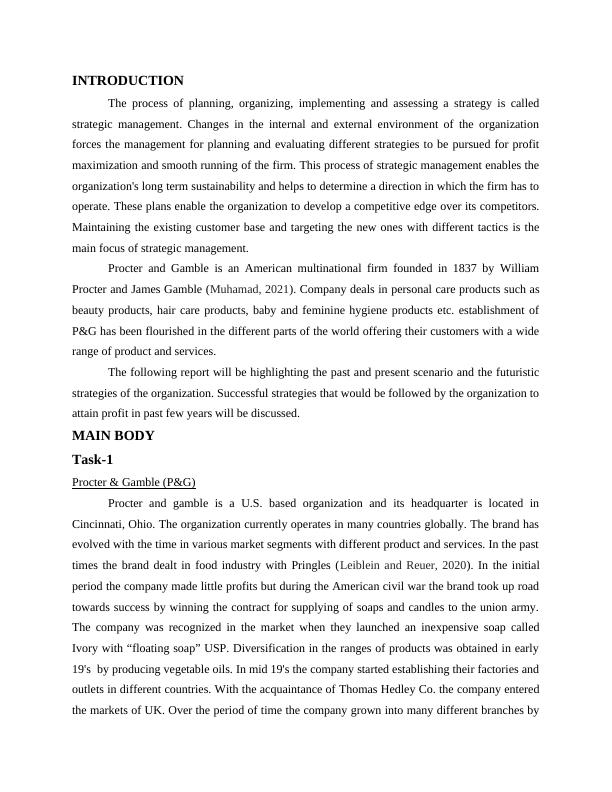
introducing different products such as Tide detergent, Prell shampoo, toothpastes etc. The star
product of the company that is Pampers diaper got popular and became most profitable with the
time. From the year 2000 to 2014 the organization acquired many big brands such as Folgers
Coffee, Pantene, Gillette, Richardson -Vicks, Max Factor etc.
From 2014 onwards the organization realized the wide diversification is leading towards
the loss in quality and decided to drop almost 100 product brands so that they can focus on the
specialization in the specific products which are giving high profits to the firm. Vicks, some of
the unpopular beauty brands and Duracell were among these dropped brands.
The strategies that are followed by Procter & Gamble throughout this evolution were:
Innovation
The organization keeps innovating their product to meet the needs of the customer and
gain a good customer feedback (Bulturbayevich, 2021). They invest in R&d of their product so it
can cope up with the changing preferences of the customer and increase the customer retention
rate. Products offered by the company are modified time to time so that it can gain relevance
with the customer needs.
Customization
The company focuses on the higher customer satisfaction rate by following the policy of
customization according to the customer. The example of this philosophy of the company is
pampers as they customized it in accordance with the needs of parents after critically observing
the situation.
Diversification
Diversified ranges of products and services offered by the company helps them target
higher customer base of different segments (Barney, 2020). The brand provides range of beauty
products, health care, home and fabric products, baby care products etc. which attracts the
customer by providing major care products in one place.
Securing the innovation
Wide ranges of innovated products in different segments is the key to success of the
organization. The organization believes in protecting their innovation and to this they apply for
patents for different innovation which acts as a barrier for its rivals top copy the product.
Acquiring best talents
product of the company that is Pampers diaper got popular and became most profitable with the
time. From the year 2000 to 2014 the organization acquired many big brands such as Folgers
Coffee, Pantene, Gillette, Richardson -Vicks, Max Factor etc.
From 2014 onwards the organization realized the wide diversification is leading towards
the loss in quality and decided to drop almost 100 product brands so that they can focus on the
specialization in the specific products which are giving high profits to the firm. Vicks, some of
the unpopular beauty brands and Duracell were among these dropped brands.
The strategies that are followed by Procter & Gamble throughout this evolution were:
Innovation
The organization keeps innovating their product to meet the needs of the customer and
gain a good customer feedback (Bulturbayevich, 2021). They invest in R&d of their product so it
can cope up with the changing preferences of the customer and increase the customer retention
rate. Products offered by the company are modified time to time so that it can gain relevance
with the customer needs.
Customization
The company focuses on the higher customer satisfaction rate by following the policy of
customization according to the customer. The example of this philosophy of the company is
pampers as they customized it in accordance with the needs of parents after critically observing
the situation.
Diversification
Diversified ranges of products and services offered by the company helps them target
higher customer base of different segments (Barney, 2020). The brand provides range of beauty
products, health care, home and fabric products, baby care products etc. which attracts the
customer by providing major care products in one place.
Securing the innovation
Wide ranges of innovated products in different segments is the key to success of the
organization. The organization believes in protecting their innovation and to this they apply for
patents for different innovation which acts as a barrier for its rivals top copy the product.
Acquiring best talents
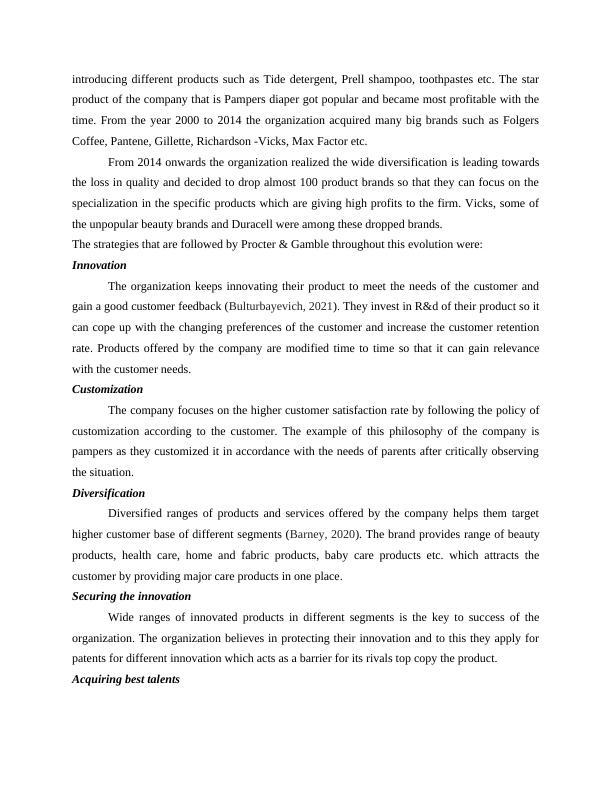
To provide the customers with the best products and services the company hires the best
candidates for the respective roles and provides them with good training. Specialized employees
for every role leads to the overall specialization of the organization.
Vision of P&G
In the initial years the organization wast started with just 2 products soaps and candles
but with the period of time the organization changed its vision towards wide diversification
which led to the non-specialization in the product (Grant, 2021). From 2014 onwards the
company realized the impact of wide diversification and decided to restructure the organization
through selling the brands which are less profitable. The brand focused on quality up-gradation
with limited diversification.
Net sales achieved by the brand in the third quarter of fiscal year 2022 was $19.4 billion
which is 7% higher than the previous year (P&G Announces Fiscal Year 2022 Third Quarter
Results, 2020). Organic sales (excluding foreign exchange) of P&G was 10% more than the last
year. Net profit earned by the firm was $3,367 million which is 4% more than the prior year.
Stakeholders of P&G
There are many stakeholders in the brands such as consumers, suppliers, managers
employees, government etc. the major financial stakeholders of the brand are the board of
directors and senior executives including:
CEO
Chief executing officer of the firm is the major financial stakeholder of the company
possessing major part of common shares of the brand.
Managers
Some managers posses financial holdings in the company and their decision also plays a
vital role in the working and future of the organization.
Board of directors
Top line managers who are responsible for any decision and possess the power to mould
the organization according to their decision. They also have holding in the company.
Heads of different departments
candidates for the respective roles and provides them with good training. Specialized employees
for every role leads to the overall specialization of the organization.
Vision of P&G
In the initial years the organization wast started with just 2 products soaps and candles
but with the period of time the organization changed its vision towards wide diversification
which led to the non-specialization in the product (Grant, 2021). From 2014 onwards the
company realized the impact of wide diversification and decided to restructure the organization
through selling the brands which are less profitable. The brand focused on quality up-gradation
with limited diversification.
Net sales achieved by the brand in the third quarter of fiscal year 2022 was $19.4 billion
which is 7% higher than the previous year (P&G Announces Fiscal Year 2022 Third Quarter
Results, 2020). Organic sales (excluding foreign exchange) of P&G was 10% more than the last
year. Net profit earned by the firm was $3,367 million which is 4% more than the prior year.
Stakeholders of P&G
There are many stakeholders in the brands such as consumers, suppliers, managers
employees, government etc. the major financial stakeholders of the brand are the board of
directors and senior executives including:
CEO
Chief executing officer of the firm is the major financial stakeholder of the company
possessing major part of common shares of the brand.
Managers
Some managers posses financial holdings in the company and their decision also plays a
vital role in the working and future of the organization.
Board of directors
Top line managers who are responsible for any decision and possess the power to mould
the organization according to their decision. They also have holding in the company.
Heads of different departments

End of preview
Want to access all the pages? Upload your documents or become a member.
Related Documents
Writing Assignment Unit 8 Management Capstonelg...
|12
|2883
|14
Marketing Strategy for Ariel Detergent: PESTLE and SWOT Analysis, USP, and Promotional Strategieslg...
|17
|5037
|480
Strategic Management: Analysis of Proctor and Gamblelg...
|19
|6799
|94
Strategic Management of Procter & Gamble Toiletrieslg...
|18
|4466
|499
Strategic management analysis - Ariellg...
|15
|4237
|230
Marketing Plan for Procter & Gamblelg...
|22
|4834
|206
